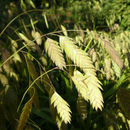en
names in breadcrumbs


Chasmanthium latifolium, known as northern wood-oats, inland sea oats, northern sea oats, and river oats is a species of grass native to the central and eastern United States, Manitoba, and northeastern Mexico; it grows as far north as Pennsylvania and Michigan,[1] where it is a threatened species.[2] The species was previously classified as Uniola latifolia (André Michaux).
Chasmanthium latifolium is a warm-season, rhizomatous, perennial grass with stems about 1 m [3 feet] tall.[3] The plant typically grows in wooded areas and riparian zones.[4]
It is used in landscaping in North America, where it is noted as a relatively rare native grass that thrives in partial shade; the plant is recommended for USDA hardiness zones 3–9 in acidic sands, loams, and clays.[5][6]
It is a larval host plant for the Northern Pearly-Eye, and its seeds are food for birds and mammals.[7] It is also eaten by the caterpillars of the pepper and salt skipper, Bell's roadside skipper, and bronzed roadside skipper butterflies.[8]
Chasmanthium latifolium, known as northern wood-oats, inland sea oats, northern sea oats, and river oats is a species of grass native to the central and eastern United States, Manitoba, and northeastern Mexico; it grows as far north as Pennsylvania and Michigan, where it is a threatened species. The species was previously classified as Uniola latifolia (André Michaux).